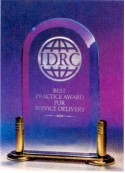| |
|
From Site Selection magazine, July 2000 I D R C ' S B E S T P R A C T I C E S Tames Hyper-Growth Tiger
"Our headcount growth was much higher than our ability to add space," says Bill Yontz, vice president for CRE. Hyper-growth, in fact, had forced Capital One to turn conference and vending space into offices, Yontz says. And as employee density rose, workplace satisfaction ratings plummeted.
Clearly, a serious situation. And one with a rebound so remarkable that Capital One CRE, along with service provider Jones Lang LaSalle (www.joneslanglasalle.com), won the coveted 1999 Best Practices Award for Strategy from the International Development Research Council (IDRC).
"What we jointly developed is a long-term strategy that supports Capital One's overall business objectives and dramatic growth, creating a working model for future real estate decision-making within a strategic framework," explains Richard McBlaine, CEO of Jones Lang LaSalle's Global Consulting group.
The portfolio management model has proved to be so strategic, in fact, that its details remain confidential. But the CRE/JLL team shared its methodology and how it's changed Falls Church, Va.-based Capital One.
And change runs from the top. Critically, the model altered the existing mindset of Capital One's top management, who'd considered real estate merely a "just-in-time" resource. Predictably, that reactionary posture had created a damaging disconnect between business objectives and CRE decisions.
The first step in creating the model to fuse CRE and overall strategy was a quiet one: The CRE/JLL team gathered data on what senior management considered business drivers, researched other fast-growth firms' coping strategies, and reviewed existing real estate practices.
"Because we were simultaneously working with Capital One to acquire space, our strategy team gained a real-time insight into existing real estate processes," says McBlaine.
Then came the rigorous, matrix-driven process of fleshing out the model.
First, the CRE/JLL team categorized the portfolio by risk and use. That led to expanding the three existing occupancy categories to five: "core office," "core call center," "core special purpose," "non-core office" and "non-core call center." Then each category was rated as "high," "medium" or "low" in its ability to satisfy specific business objectives like "providing sufficient capacity for future growth."
The team's next step was to pinpoint each occupancy category's "primary real estate characteristics" in attaining business objectives. For future growth capacity, for example, the characteristic was "deal structure," including "initial occupancy size relative to additional adjacent real estate supply" and "quality and quantity of growth options."
That led to perhaps the model's most powerful matrix, which defined each occupancy category's "preferred real estate solutions" -- even including photographic examples and recommendations for deal structure and language.
Moreover, the model radically redefined the CRE-finance linkage: It stipulated that CRE's identification of optimal properties would precede identification of optimal financing methods. In addition, the model created a set of "pre-approved financing alternatives," specifying financial criteria weightings for each occupancy type.
And that was only part of the model's success in integrating Corporate Infrastructure ResourcesTM, an area in which IDRC has been a trailblazer. All major players in Capital One workplace management -- real estate, finance, human resources, information technology and business units -- now coordinate their efforts. Monthly "capacity planning sessions," for example, pinpoint process trigger dates for timely new-space delivery.
Few CRE strategies have such far-reaching impact, not only mitigating current workplace woes, but also embedding a footprint in the future.
Says Yontz, "We've created a corporate real estate play-book, adopting company-wide business practices and decision-making processes that will guide all of our future real estate decisions."
-- Jack Lyne

| |
|
| |
 | Site Selection Online | SiteNet | Feedback | Search SiteNet | ©2000 Conway Data, Inc. All rights reserved. SiteNet data is from many sources and is not warranted to be accurate or current.
|
 Frankly, most companies would die for problems like Capital One Financial's (
Frankly, most companies would die for problems like Capital One Financial's (